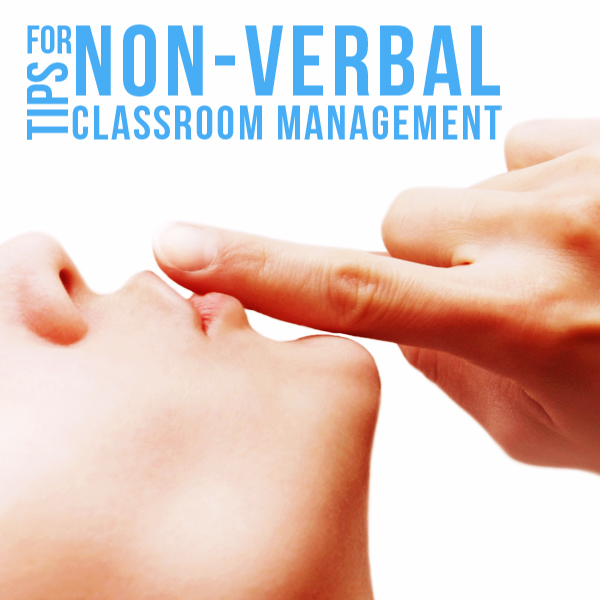This is the second post in the new series I’m introducing on The Cornerstone called Real Teachers, Real Tips. Each month, I’ll invite one educator to share a few classroom management tips that have worked in his or her classroom. I’m hoping to feature a wide cross-section of teachers from all different parts of the world, at all different grade levels, in all different teaching scenarios. Want to be featured here? Just fill out the guest blog form!
August’s featured teacher is Tammi Pittaro, a super talented educator who’s been in the field for 35 years!! Thank you, Tammi, for sharing your perspective here.
Hello! My name is Tammi from presentlygifted.org. I am a fairly new blogger and mostly write about teaching students with high academic potential. I am excited and honored to be here as the guest blogger! Angela has asked me to share a post about non-verbal classroom management. She believes, as I do, that managing a classroom successfully is the backbone of good teaching. But first, just a little about me…

I live and teach in southeastern New Jersey, not far from the bright lights of Atlantic City and the Pine Barrens forest. I have taught in the same school district for the past 35 years. About half of this time has been at the elementary level as a classroom teacher, and the other half as a gifted and talented/enrichment specialist in grades K through 8. Currently, I teach and coordinate our district’s pullout gifted and talented program. I teach over 100 identified students in small groups in three schools during the course of the week, as well as working with whole classrooms of kindergarten students. My program is project-based and concentrates on developing creativity, critical thinking skills, problem solving and how to do authentic research. A good dose of classroom technology is thrown into the mix as well. I love, love, love to teach and work with kids of all ages, and after 35 years, teaching continues to make me smile everyday!
As I am gearing up for a new school year, I am thinking about the basics. In my opinion, classroom management is the glue that holds everything together. A strong classroom management system has always been important to me, but as a teacher who works with various groups of children each day, I have come to truly realize that it is the key to successful teaching. Since the time I have with my students is limited, it is important that we make the most of every moment. Classroom focus needs to be on learning instead of discipline. There is just too much curriculum to teach and too little time for interruptions due to student behaviors such as talking, daydreaming, distracting others and fooling around. I talk all day long as it is, so I don’t want to use my voice any more than I need to! Nonverbal classroom management techniques can really help to make the classroom a more productive and happy place for everyone.

What does nonverbal classroom management look like and how can a teacher keep students focused on learning without using words or sounds? Here are five very simple, no-cost, low-tech ways that have worked for me over the years.
1. One, Two, Three…Eyes on Me!
I have found that making eye contact with each child early and often in the day or the period helps him or her stay on track in the classroom. I make sure I greet each student warmly by name and look him or her in the eye upon entering my classroom. Then, during direct teaching or working with a few students, I make sure I continue to do so. Students are more likely to stay on task and behave appropriately when they know the teacher is watching. Making eye contact, especially in Western cultures, signifies respect, interest, appreciation, trust and friendship. It’s an important skill to teach young children and to model as you teach.
2. Work the room
Where you stand or teach can make a big difference. Moving around as you teach helps keep your students focused. Without skipping a beat, you can move nearer to those students who might be distracted or fooling around. Your proximity will send a message to get back to business, and you don’t usually have to say a word. Pause for a few moments near the student who has been off-task and teach from there for a bit before moving on. A little eye contact helps here as well. A good practice while students are working independently or in small groups is to keep moving among them. I’ve observed (and experienced first hand) that when teachers sit, trouble can be brewing at the opposite end of the classroom! And most of us can use the extra physical activity!
3. Sign Language
I found sign language posters by Rick Morris (www.newmanagement.com) years ago, and I have used them ever since with students in grades K through 8. I use the first five, although he has now has fourteen in all. I have them posted in my classroom and teach them the first day of school. They are easy for the students to learn and very effective, especially in larger groups. Students like them, too! Check out Rick’s website for more good tips!
4. Keep a silent eye on the clock (or your watch)
Want to get your class quiet quickly? Just look at the clock, or your watch, assume a sad expression and shake your head just a bit. Don’t say a word! Your students will get the message loud and clear. If you deduct the time you have waited from allotted preferred activity time, such as recess or classroom games (see Tools for Teaching: Discipline, Instruction, Motivation by Fred Jones), you won’t have to wait very often for silence. I first observed this during student teaching by an experienced teacher, and it still works after all these years!
5. “S-O-R-R-Y”
In my experience, this is really effective in the primary and elementary grades. On the first day of school, explain to your students that if you ever have to write SORRY on the board, it will mean that the class has lost a privilege they enjoy, such as free time or recess. When undesired behaviors occur, start to print the word “S-O-R-R-Y” one letter at a time on the board without making a big deal about it. Don’t erase the any of the letters you have written until the end of the day or after the preferred activity. Rarely will you get to “Y.” I promise! Works like a charm.
Have you tried (or would you like to try) any of these strategies with your kids? Do you use other non-verbal classroom management techniques in your classroom? Tell us in the comments!

Angela Watson
Founder and Writer
Sign up to get new Truth for Teachers articles in your inbox
Discussion
OR

Join our
community
of educators
If you are a teacher who is interested in contributing to the Truth for Teachers website, please click here for more information.

















I am fascinated by the innovative methods used..Most often the initial moments are the challenge.once the quiet is achieved..The class gets hooked..However a sound preparation on the part of the teacher is imp
Since I am the coordinator of the school…I conduct the morning assembly…children tend to be excitable…I just praise one class which has settled. ..eg..class 4 B is standing smartly and silently..and I can see class 3C follow suit..soon all 15 classes get their act together..I also narrate a story or discuss something topical to occupy them.till the actual assembly begins…believe me..I have been able to not only get quiet but I have now voracious readers among kids
I taught in classrooms for 24 years before becoming a program specialist for special education. This included 14 years as a general education teacher followed by 10 years as a special education teacher. I helped mentor new teachers my last seven years. I agree that good classroom management is an extremely critical piece that allows a teacher to enjoy teaching when it is done well. I think all of Tammi’s classroom management suggestions are excellent. I actually began to use the sign language for the deaf because I had a mainstreamed deaf student in my class one year, and I noticed several benefits. Students would sometimes use it to communicate with each other or me without bothering their classmates. I also noticed some students getting better spelling test scores. I would see them spelling out the sounds of the word on their hands as they were taking the test.
From my experience these work. Proximity & eye contact acknowledge students as people and satisfy much of their neediness. You can also play “sherrades” (SP?) by motioning to kids any message. They can usually figure it out or another student will be watching and say it for them. Keeping the focus on self-management and being a self-directed learner help with the need to “SORRY” or other punitive measures. The more you can really BE with them and be PRESENT with them, the more support & community they feel. They can feel acknowledged and settle into learning mode.
Tip: to help with self-directed, have all resources available & labeled, and steps to do listed on board.
Great tips.
Presence is so important! Thanks for sharing this.
I have a big red tin, filled with treats – if I want attention and absolute silence, I shake the bucket. Sometimes, everyone gets a treat, sometimes no one gets a treat, sometimes just one person who was the first person to be ready to listen gets a treat. We all love the big red tin… And usually just walking in that direction gets the children’s attention.. But hearing that PARTICULAR /exciting noise gets me undivided attention.
If the day is very very exciting and energy levels are high as the sky, I also use the Power Test, a big shout out to the person who started The WorkShop Way, it’s the best system Ever… I believe her comment that the hardest thing and most important thing anyone can learn is to control themselves. To this end, the challenge is to look at the sweep hand of th clock and be 100% still for 2 minutes. I have had the children do that task individually as part of thier daily work but have also made the whole class do it with me as I whisper comments about the sounds we are able to hear, and perhaps people who are being extra still or those with a slight movement in thier hand or arm. Try it, it’s a truly amazing experience to the whole vibe of the room and not just quiet but a tranquility comes over the room that’s very different.
I’d never heard of the Power Test. Thanks for sharing!
Hello!
I just recently started teaching a very young group of 15-18 2 year olds. What advice can anyone give to get their attention? I’ve counted, and taken away privileges, but they’re 2 and I’m not sure they’ve grasped the concept quite yet. any advice is completely welcome!
See if any of these ideas for quieting a class will help you. For preschoolers, I recommend songs and fingerplays–works like a charm!